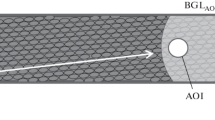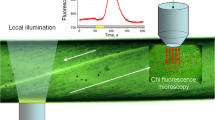Abstract
The role of cytoplasmic streaming in pattern formation at the plasma membrane and chloroplast layer was examined with Chara corallina Klein ex Willd. cells exposed to nonuniform illumination. Our hypothesis was that the exchange of ions and metabolites between the chloroplasts and the cytoplasm in the illuminated cell area alters the composition of the cytosol while the flow of modified cytoplasm induces asymmetrical changes in the plasmalemmal transport and fluorescence of chloroplasts in the adjacent shaded areas. The hypothesis was tested by measuring the H+-transporting activity of plasmalemma and non-photochemical quenching (NPQ) in shaded areas of Chara cells at distances of 1–5 mm on either side of the illuminated region (white light, 1000 μmol/(m2 s), beam width 2 mm). When measured at equal distances on opposite sides from the illuminated region, both pH and NPQ changes differed considerably depending on the direction of cytoplasmic movement at the light-shade boundary. In the region where the cytoplasm flowed out of irradiated area, the formation of alkaline zone (the plasma membrane domain with a high H+-conductance) and NPQ in chloroplasts was observed. In the vicinity of light-shade boundary where the flow was directed from the shade to the illuminated area, neither alkaline zone nor NPQ were formed. The results demonstrate the significance of cyclosis in the transfer of physiologically active intermediate that affects the membrane transport, the functional activity of chloroplasts, and the pattern formation in the plant cell.
Similar content being viewed by others
Abbreviations
- AZ:
-
alkaline zone
- NPQ:
-
non-photochemical quenching of chlorophyll fluorescence
- pH0 :
-
local pH in the outer medium near the cell surface
References
Verchot-Lubicz, J. and Goldstein, R.E., Cytoplasmic Streaming Enables the Distribution of Molecules and Vesicles in Large Plant Cells, Protoplasma, 2010, vol. 240, pp. 99–107.
Shimmen, T. and Yokota, E., Cytoplasmic Streaming in Plants, Curr. Opin. Cell Biol., 2004, vol. 16, pp. 68–72.
Pieruschka, R., Schurr, U., Jensen, M., Wolff, W.F., and Jahnke, S., Lateral Diffusion of CO2 from Shaded to Illuminated Leaf Parts Affects Photosynthesis Inside Homobaric Leaves, New Phytol., 2006, vol. 169, pp. 779–788.
Lucas, W.J. and Dainty, J., Spatial Distribution of Functional OH− Carriers along a Characean Internodal Cell: Determined by the Effect of Cytochalasin B on H14CO −3 Assimilation, J. Membr. Biol., 1977, vol. 32, pp. 75–92.
Bulychev, A.A., Polezhaev, A.A., Zykov, S.V., Plyusnina, T.Yu., Riznichenko, G.Yu., Rubin, A.B., Jantoβ, W., Zykov, V.S., and Müller, S.C., Light-Triggered pH Banding Profile in Chara Cells Revealed with a Scanning pH Microprobe and Its Relation to Self-Organization Phenomena, J. Theor. Biol., 2001, vol. 212, pp. 275–294.
Bulychev, A.A., Cherkashin, A.A., Rubin, A.B., and Müller, S.C., Distribution of Acid and Alkaline Zones on the Cell Surface of Chara corallina under Stationary and Local Illumination, Russ. J. Plant Physiol., 2002, vol. 49, pp. 715–722.
Bulychev, A.A. and Vredenberg, W.J., Spatio-Temporal Patterns of Photosystem II Activity and Plasma-Membrane Proton Flows in Chara corallina Cells Exposed to Overall and Local Illumination, Planta, 2003, vol. 218, pp. 143–151.
Smith, J.R. and Walker, N.A., Effects of pH and Light on the Membrane Conductance Measured in the Acid and Basic Zones of Chara, J. Membr. Biol., 1985, vol. 83, pp. 193–205.
Bulychev, A.A. and Krupenina, N.A., Transient Removal of Alkaline Zones after Excitation of Chara Cells Is Associated with Inactivation of High Conductance in the Plasmalemma, Plant Signal. Behav., 2009, vol. 4, pp. 24–31.
Bulychev, A.A. and Kamzolkina, N.A., Effect of Action Potential on Photosynthesis and Spatially Distributed H+ Fluxes in Cells and Chloroplasts of Chara corallina, Russ. J. Plant Physiol., 2006, vol. 53, pp. 1–9.
Krupenina, N.A. and Bulychev, A.A., Action Potential in a Plant Cell Lowers the Light Requirement for Non-Photochemical Energy-Dependent Quenching of Chlorophyll Fluorescence, Biochim. Biophys. Acta, 2007, vol. 1767, pp. 781–788.
Stahlberg, R., Cleland, R.E., and Volkenburgh, E., Slow Wave Potentials — a Propagating Electrical Signal Unique to Higher Plants, Communication in Plants, Baluška, F., Mancuso, S., and Volkmann, D., Eds., Berlin: Springer-Verlag, 2006, pp. 291–308.
Rhodes, J.D., Thain, J.F., and Wildon, D.C., Signals and Signalling Pathways in Plant Wound Responses, Communication in Plants, Baluška, F., Mancuso, S., and Volkmann, D., Eds., Berlin: Springer-Verlag, 2006, pp. 391–401.
Author information
Authors and Affiliations
Corresponding author
Additional information
Original Russian Text © A.A. Bulychev, S.O. Dodonova, 2011, published in Fiziologiya Rastenii, 2011, Vol. 58, No. 2, pp. 202–207.
Rights and permissions
About this article
Cite this article
Bulychev, A.A., Dodonova, S.O. Role of cyclosis in asymmetric formation of alkaline zones at the boundaries of illuminated region in Chara cells. Russ J Plant Physiol 58, 233–237 (2011). https://doi.org/10.1134/S1021443711020038
Received:
Published:
Issue Date:
DOI: https://doi.org/10.1134/S1021443711020038




